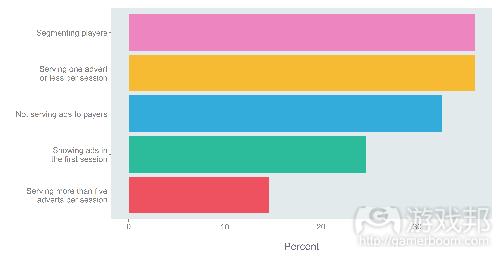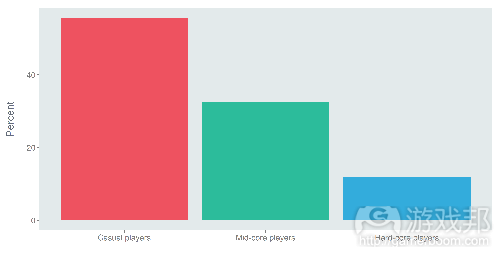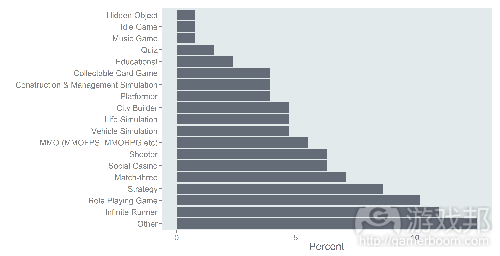从游戏内部广告研究中获得的5个要点
作者:James Batchelor
分析专家DeltaDNA最近对开发者进行了一项有关开发者在免费游戏中使用游戏内部广告以及这么做的结果的研究。
最终他们基于调查者那高盈利免费游戏是如何使用各种类型的广告而获得了一份报告。
而我们从这份研究中提取了5个关键要点。
1.开发者要谨慎
在所有的调查对象中他们最害怕的便是因为呈现过多广告或者因为使用广告而影响到玩家的用户留存。当询问开发者担心玩家因为广告而受影响的程度,在5分的选项中参与者的平均分数为3.58。
也就是有超过1/3的开发者(即36%)在每个游戏回合中只会呈现一个广告甚至不会呈现任何广告。同时,36%的开发者会去划分他们的非付费玩家,并且还有33%的开发者会去保护他们的消费者。
2.自信并非成功的保证
只有54%的调查对象认为游戏内部广告是正确的做法。40%的调查者认为如果能够有效使用广告便会成为成功的关键。
有趣的是那些相信自己使用了最佳策略的开发者通过广告所获取的收益只占其总收益的34%,
3.工作室仍然相信休闲内容
大多数开发者所瞄准的是休闲用户,即有58%的开发者表示他们最高盈利的免费手机游戏便是面向这类型用户。这一数值是31%瞄准中核用户的工作室的2倍,并且只有1/10的调查对象是面向传统硬核用户。
DeltaDNA进一步分析了这些工作室并发现比起在中核游戏或硬核游戏中,这些开发者更有可能将他们的用户划定在休闲游戏中。并且比起非休闲用户,休闲用户更有可能接受在一个游戏回合中出现5个或多个广告。
4.市场上并非全是策略游戏
多亏了Supercell,Machine Zone等公司,我们可以假设大多数免费游戏都是来自策略市场,但只有不到40%的调查者表示他们最高盈利游戏是行动游戏。
实际上当你进一步分解策略游戏时会发现第三受欢迎的类型是无限跑酷和RPG。
但是DeltaDNA的报告表示,当提到广告呈现时这些游戏类型并没有太多区别。而当提到每一回合呈现多少广告时,行动游戏和其它游戏的区别就变大了。
更有趣的是行动游戏比较不可能使用广告去炮轰玩家,即只有4%的调查者表示他们会在每个游戏回合中呈现5个以上的广告。相比较而言,18%的其它游戏开发者则表示他们会在游戏回合中呈现5个或以上的广告。
5.大多数开发者使用了混合广告
从调查者的报告中我们可以发现插播广告是最受欢迎的广告类型,即67.4%的工作室会使用这种广告。而能够提供给观看视频或参与广告的玩家游戏内部虚拟货币的奖励性广告的使用率为56.2%,名列第二。
横幅广告作为较为传统的游戏内部广告在免费游戏中则仍然拥有39.3%的使用率。
许多工作室会选择综合这些广告,即有1/4的调查者表示他们会结合奖励性广告和插播广告。而基于插播广告的策略则是第二受欢迎的选择,即有超过15%的工作室在使用这种方法。
(本文为游戏邦/gamerboom.com编译,拒绝任何不保留版权的转发,如需转载请联系:游戏邦)
Five lessons learned from DeltaDNA’s in-game advertising study
By James Batchelor
Analytics experts DeltaDNA recently conducted a survey quizzing developers about the use of in-game advertising in their free-to-play games – and the results are in.
A free report has been compiled based on how respondents’ highest monetising free-to-play games use a variety of ad types. Develop helped to promote the survey to its readers, expanding the number of developers that took part in the study.
We’ve taken away five of the key points we learned from this research, which are detailed below. Alternatively, you can download the full report for free, which also includes DeltaDNA’s recommendations on best practices when it comes to in-game advertising.
1. Developers are cautious
One of the greatest fears among respondents was damaging player retention by displaying too many ads – or even using ads at all. Asked how concerned they were about frightening players, with five being very concerned, participants scored an average of 3.58.
As a result, more than a third of these developers – 36 per cent – show only one ad or none during each gaming session. Meanwhile, 36 per cent also segment their non-paying players, while a further 33 per cent protect their spenders.
2. Confidence is no guarantee of success
Only 54 per cent of all respondents felt certain they were taking the right approach when it comes to in-game advertising. 40 per cent of participants believe that your overall strategy is the key to success when it comes to using ads effectively – almost double the number that put their faith in good formatting.
Interestingly, those who believe they are using the best strategy report that an average of only 34 per cent of their revenue comes from this advertising.
3. Studios still believe in casual
Most developers are targeting a casual audience, with 58 per cent of developers saying their highest monetising free-to-play mobile games have been built for this audience. This is almost double the 31 per cent of studios targeting the mid-core audience, while only one in ten participants are focused on the traditional hardcore audience.
DeltaDNA analysed these studios’ results further and found that developers are more likely to segment their players in casual games than in mid-core or hardcore games. Casual players are also more than twice as likely to be presented with five or more in-game ads during a single play session than non-casual audiences.
4. It’s not all Clash of Clans clones out there
Thanks to Supercell, Machine Zone and others, it’s easy to assume that most of the free-to-play titles out there are found within the strategy market, but just under 40 per cent of survey participants actually report that their highest monetising games are action titles.
In fact, when you break this down further strategy is, in fact, the third most popular genre behind infinite runners and RPGs.
However, DeltaDNA reports that genre doesn’t actually make too much difference when it comes to how ads are being served. When it comes to how many action games serve one or fewer ads per session compared to other genres, the difference is negligible.
Of more interest is the fact that action games are less likely to bombard their players with ads, with only four per cent showing more than five ads per session. Comparatively, 18 per cent of all other games show five or more ads.
5. Most devs use a mixture of ads
Interstitial ads proved to be the most popular type used by survey participants, utilised by 67.4 per cent of studios. Rewarded ads, which give players virtual in-game currency for watching a video or otherwise engaging with the ad, were a close second at 56.2 per cent.
Banner ads, a more traditional form of in-game advertising, still remain popular with 39.3 per cent of studios using them in their free-to-play games.
Many studios use a mixture of these types, with almost a quarter of all respondents favouring a combination of rewarded and interstitial. An interstitial-led strategy was the second-most popular choice, with just over 15 per cent of studios using this(source:develp-online)
上一篇:分析《毁灭战士》优秀的关卡设计
下一篇:在游戏开发阶段寻求反馈的重要性













































 闽公网安备35020302001549号
闽公网安备35020302001549号